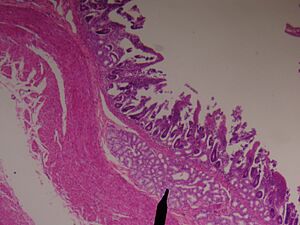Brunner's glands facts for kids
Brunner's glands, also called duodenal glands, are tiny glands found in the first part of your duodenum. The duodenum is the very first section of your small intestine, right after your stomach. These special glands are located in the inner lining of the duodenum.
Their main job is to make a special kind of fluid. This fluid is rich in mucus and is alkaline, which means it's the opposite of acidic. Think of it like a protective shield for your intestine.
Contents
What Do Brunner's Glands Do?
Brunner's glands have several important roles in your digestive system. They help keep your duodenum healthy and working well.
Protecting Your Duodenum
When food leaves your stomach, it's very acidic. This acidic mix is called chyme. The duodenum needs protection from this strong acid. Brunner's glands produce a lot of mucus and a substance called bicarbonate. Bicarbonate helps to neutralize, or cancel out, the stomach acid. This protects the delicate lining of the duodenum from getting damaged.
Helping Digestion
Your small intestine needs a specific environment to digest food properly. Many important enzymes that break down food work best in an alkaline (non-acidic) setting. The fluid from Brunner's glands helps create this alkaline condition. This allows the enzymes to do their job, which is to break down food into tiny pieces. These tiny pieces can then be absorbed into your body.
Lubricating the Intestine
The mucus produced by these glands also helps to lubricate the inside walls of your intestine. This makes it easier for food to move smoothly through your digestive system. It's like adding oil to a machine to help its parts move without friction.
Helping Cells Grow
Brunner's glands also make a special protein. This protein helps the cells in your intestine grow and stay healthy. It also sends a signal to your stomach to slow down its acid production. This is another way these glands help protect the duodenum from too much acid.
Who Discovered Them?
These glands are named after a Swiss doctor named Johann Conrad Brunner. He was the first person to describe them in detail. This happened a long time ago, in the late 1600s.


